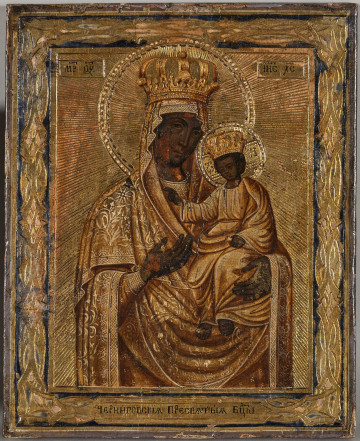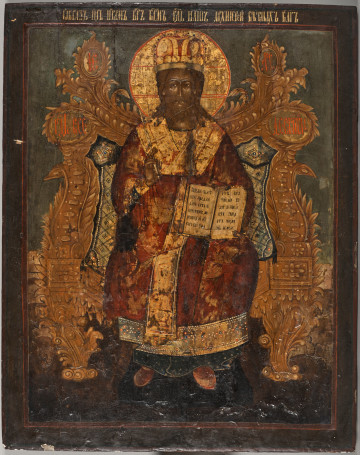
The Mother of God of Hodigitria
19th (?) century
Castle Museum in Łańcut
Part of the collection: Ikony
Multi-panel icon,The Crucifixion, Christ the Angel of the Great Counsel, Mother of God Eleusa Salvation of the Lost, Mother of God Hodegetria of Częstochowa, martyrs - Gurias, Samon, and Habib. The combination of several depictions on one canvas board is part of the Eastern tradition. In the lands of Rus, such icons probably appeared at the end of the 14th c.; the oldest known examples come from the 15th c., from Veliky Novgorod. Usually, the especially revered, miraculous images of the Mother of God, saints-intercessors in particular needs, or scenes from the Gospels were combined. The following figures were placed on the displayed icon (starting with the top-left corner): Christ the Angel of the Great Counsel, Mother of God Eleusa, Mother of God Hodegetria, saints - Gurias, Samon, and Habib. The depictions complement the central image of the Crucified Christ, crowned with the figure of the Lord of the Hosts - Yahweh Sabaoth (see S.12792-12795MŁ; S.12871MŁ; S.12872MŁ; S.12875MŁ). The depiction of Christ shows the youthful Saviour before the Incarnation as a winged Angel in archangel robes and a halo. In the halo, an eight-pointed star created by two intersecting rhombuses is inscribed; it symbolises the Majesty of the Creator and the mystery of His Divinity. Christ was called the Angel of the Great Counsel for the first time by John of Damascus in the Oration on the Nativity of the Mother of God, in reference to the prophecy of Isiah (Isiah 9:5-6). Before the image of the Mother of God Eleusa in the Salvation of the Lost iconographic type, one would pray for those without hope for salvation and those abandoning the Church (see S.12682MŁ). The depiction of the Mother of God Hodegetria, sometimes called the Częstochowa Mother of God, is a variant of the Hodegetria icon from Jasna Góra. The Jasna Góra icon was given to the Russian armies by the Pauline Fathers in 1813 after the Russian forces chased out the troops of Napoleon and took over Częstochowa. The variants placed in the Kazan Cathedral in Saint Petersburg are known in Russia as Melting of Hardened Hearts. The martyrs from the time of Diocletian - Gurias, Samon, and Habib - are always depicted together; they are the protectors of the newly married, as well as of the wives whose husbands became dissatisfied with them. Teresa Bagińśka-Żurawska https://orcid.org/0000-0002-9243-3967
Dimensions
height: 35 cm, width: 29 cm
Object type
Icons
Technique
gilding, tempera
Material
gold, tempera, wood
Origin / acquisition method
decyzja administracyjna
Creation time / dating
Creation / finding place
Owner
Castle Museum in Łańcut
Identification number
Location / status

19th (?) century
Castle Museum in Łańcut

1800 — 1850
Castle Museum in Łańcut

1800 — 1899
Castle Museum in Łańcut
DISCOVER this TOPIC
Museum of King Jan III's Palace at Wilanów
DISCOVER this PATH
Educational path